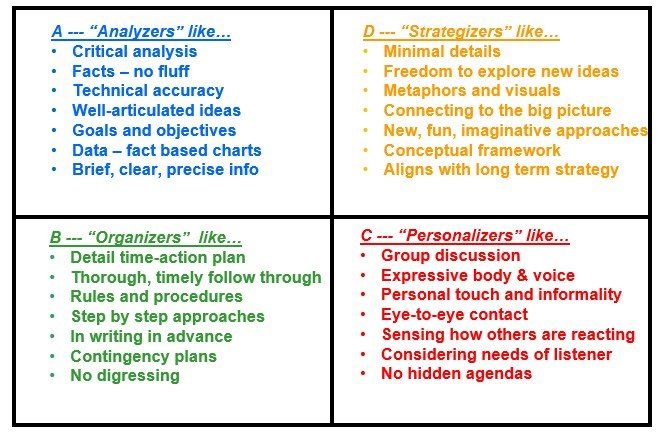Effective Change Communications...Tip #3: Communicate your change message in a Whole Brain® Way.
First understand how people prefer to be communicated with...then use the "Optimal Flow" to create a powerful message everyone can hear.
In my last post on effective change managementcommunications, I focused on Tip #2 – beingclear about the behavioral changes expected of the people in your organization.(For Tip #1 – creating your “why”message of the change, click here .)
Now that you have a clear message about the why of thechange and what behaviors are expected, how do you ensure that you are actuallycommunicating your message in a way that your employees can hear it? I like tosay – if you have 10 people in the room, you should assume you have a WholeBrain® present!
I have been certified to use the Herrmann Whole Brain® Model and the Herrmann BrainDominance Instrument (the HBDI®,what I call “the user-friendly Myers-Briggs”) for more than 20 years since I firstdiscovered it when I was an organization effectiveness leader at Coca-Cola.
The HBDI®helps people to understand their preferred way of thinking. As you can see from the chart above, eachquadrant also has a preferred way of communicating.
So how do you ensure your change message is meeting the needsof all listeners?
By using the Whole Brain® “Optimal Flow”…
- Yellow/Strategizer What’sthe “why” behind the change? How does this change fit into the big picture? Describe(and justify) the change clearly in a statement lasting no longer than oneminute – without the use of jargon.
- Blue/Analyzer What’sthe logic behind the decision? What’s the goal or objective of the change? Whatare the facts? “Sell the problem before you try to sell the solution.”
- Red/Personalizer Whatis the impact on me? What is expected of me? What are the implications for mycustomers? For the people on my team? Get clear on what people are being askedto let go of, to give up - relationships, current methods, values,expectations.
- Green/Organizer Whatare the specifics of the change? What are the risks to me? Understand what thechanges will mean in behavioral terms (e.g. answering customer complaints in 24hours), as well as structural (e.g. realigning teams by product instead ofregion). Be as specific as you can.
If you would like tolearn more about Whole Brain Thinking, the HBDI and how I have used thisassessment to help leaders learn their own and their team's thinking and communication preferencesto ensure a more successful change message, then send me an email at KDouglas@FireFlyFacilitation.com or call me at 678-388-0448.






